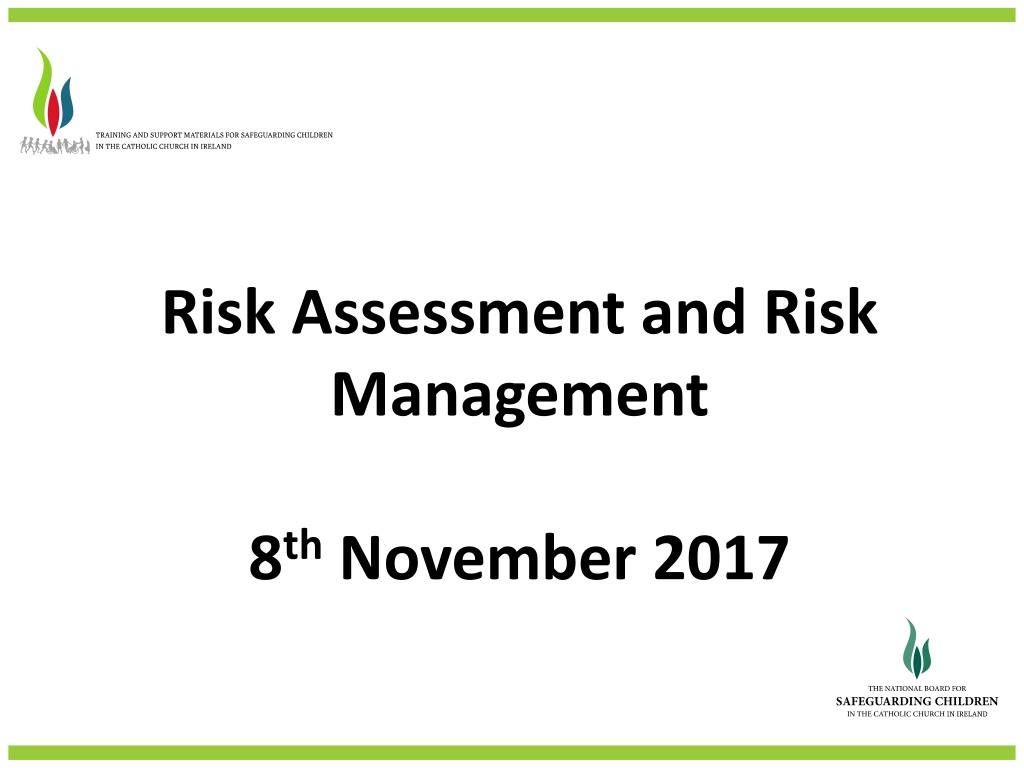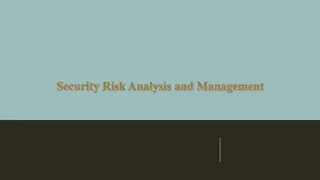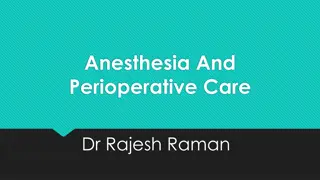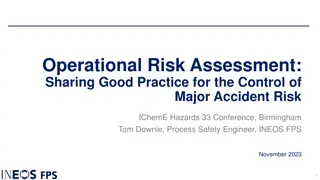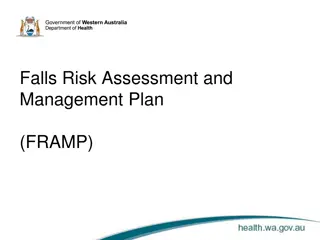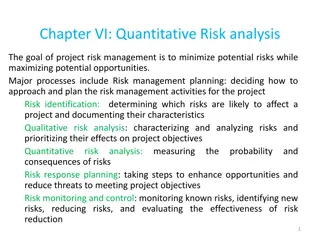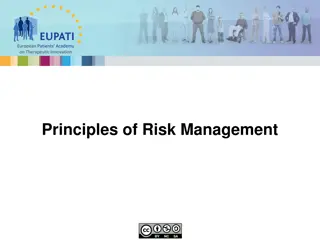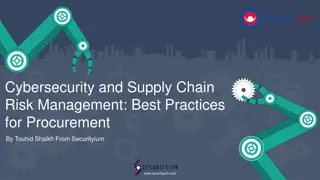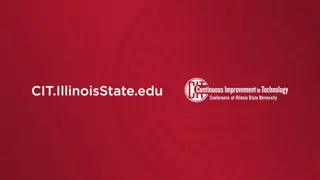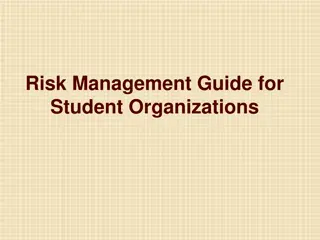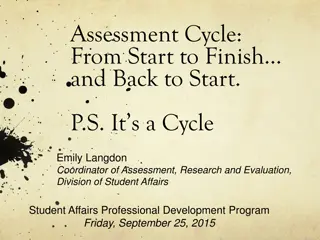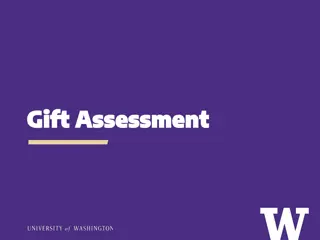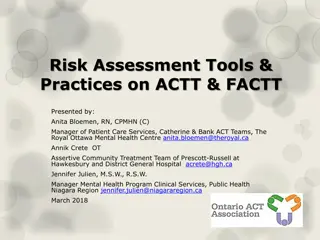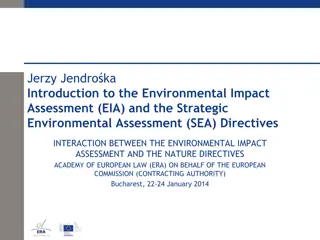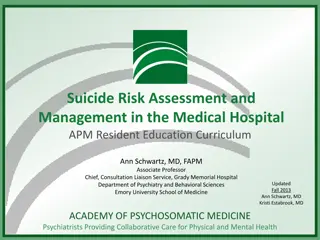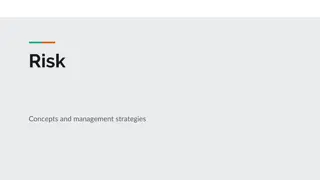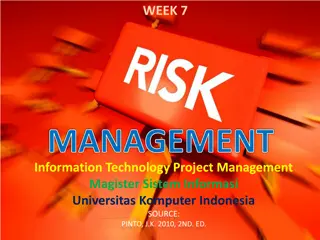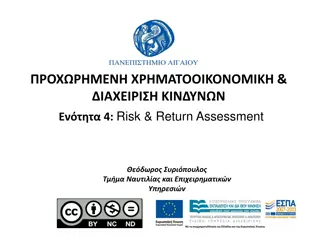Risk Assessment and Risk Management
This document outlines a training day on Risk Assessment and Management held on 8th November 2017. It covers topics such as roles, responsibilities, statutory assessments, monitoring, and thresholds for reporting. The training aims to provide insights into church processes, statutory authorities' involvement, and effective risk assessment frameworks. Attendees are reminded to seek advice when needed, as the content emphasizes the importance of competent assessment and reporting practices.
Download Presentation

Please find below an Image/Link to download the presentation.
The content on the website is provided AS IS for your information and personal use only. It may not be sold, licensed, or shared on other websites without obtaining consent from the author.If you encounter any issues during the download, it is possible that the publisher has removed the file from their server.
You are allowed to download the files provided on this website for personal or commercial use, subject to the condition that they are used lawfully. All files are the property of their respective owners.
The content on the website is provided AS IS for your information and personal use only. It may not be sold, licensed, or shared on other websites without obtaining consent from the author.
E N D
Presentation Transcript
Risk Assessment and Risk Management 8th November 2017
Colette Stevenson Welcome and Prayer
Aims To share Church process To provide an assessment outline To highlight the processes of the statutory authorities To discuss monitoring
Training Day Risk Assessments and Monitoring 8th November 2017 Time 10.00 What Welcome and Introductions Who Colette Stevenson Aims of the Day Roles and Responsibilities 10.10 Teresa Devlin Thresholds for Reporting Mandated Persons Initial Screening 10:30 Teresa Devlin Risk Assessment framework and NBSCCCI templates 11:15 11.30 COFFEE BREAK Statutory Assessment - TUSLA Geraldine O Sullivan, Principal Social Worker TUSLA Specialist Inquiry Team 12.15 Statutory Assessment HSCT Derek Ballard Principal Social Worker HSCT 1.00 14.00 15.00 Lunch Monitoring Recap on Day Issues and Questions Teresa Colette
Teresa Devlin Roles, Responsibilities, Thresholds and Mandated Persons
Remember: You are not statutory personnel nor skilled in assessments Seek advice as required
Tusla Responsibility Section 3 of Part 11 of Child Care Act 1991 Assess welfare needs of a child Assessment of risk
HSCT Responsibility Children (NI) Order 1995 Article 66 (1) (b). Investigation will include conducting an initial assessment, liaising with the family and other key professionals, to assess the child s needs for support and protection
Police Responsibility Assess if a crime has been committed
Church Responsibility Notify statutory authorities if threshold has been reached Determine if respondent can remain in ministry Decide on any restrictions
Teresa Devlin Initial Screening
Initial enquiry to establish if the threshold for reporting has been reached Establishing the name of the complainant, the nature of the allegation and the name of the respondent; Checking if the respondent was in the reported location at the time of the alleged abuse.
Initial Screening Does information reach a semblance of truth? Is there statutory authority action What is the ministry of the respondent Seek advice from NCMC/Advisory Panel Respondents right to know
Initial Assessment of Risk Guidance 4.2A 4.2B Template 1 https://www.safeguarding.ie/roles2?tas k=document.viewdoc&id=293
Issues to be considered when assessing initial risk Is the allegation recent or of a historical nature? Has the allegation continued over a significant period of time? Is there any evidence to support complaints?
What is the respondents attitude to the allegations/complainants?
What is the respondents role in the Church? Does the respondent have access to children? Can they continue to work in public? Detail what they can/cannot do.
What is the number, gender and age range of complainants? Have there been any other previous complaints? Is there any evidence to support complaints? What is the respondent s attitude to the allegations/complainants?
Are there other contributory factors that may increase risk (e.g. alcohol, single accommodation, refusing to comply with safeguarding process, etc.)?
Are there any issues with the respondent s accommodation? Who has the respondent shared information about the allegations with? What action has the respondent taken to protect themselves or others?
Positive Factors What internal strengths does the respondent have? What external supports have they put in place for themselves (personal/environmental)?
Restrictions Ministry Priests Clothing Accommodation Support Contact with complainant
Interim Management Plan 4.2B Template 3: Example Interim Management Plan https://www.safeguarding.ie/roles2?task =document.viewdoc&id=293
4.2B Templates Template 1: Sample Risk Assessment Framework Template 2: Sample Risk Management Update Tool Template 3: Sample Interim Management Plan Template 4: Sample Notification to Follow Child Safeguarding Policy and Procedures
Geraldine O Sullivan Principal Social Worker (Tusla Specialist Inquiry Team)
Historical Child Sexual Abuse Where an Adult discloses CSA in childhood implications for current safeguarding
SAVI report (2002) 25-30% of adults reported having been sexually abused as children
What research tells us about CSA in Ireland One third of women and one quarter of men have experienced Child Sexual Abuse. 47% of participants reporting CSA in the SAVI Survey had never reported the abuse to another person. 8% had reported to AGS. 4% had reported to medical personnel. 12% had reported to a therapist or counsellor. 25% of perpetrators of abuse were reported to be under the age of 17yrs. 80% Perpetrators were known to their victims (family/family friend). SAVI Report, DRCC 2002
Mental Health and CSA Those who have experienced penetrative or attempted penetrative abuse are 8 times more likely to have been an inpatient in a Psychiatric Unit in their lifetime. 25% of women and 16% of men who experienced abuse disclosed symptoms of PTSD during their lifetime. Perception amongst mental health professionals that mandatory reporting of abuse to statutory authorities may be a barrier to exploring these issues with patients. SAVI Report, DRCC 2002
No test to identify offenders External barriers - social stigma/repression of open dialogue about child abuse No symptom presentation which specifically proves CSA Internal barriers - shame and fear commonly seen in those affected by abuse Rarely any proof that a crime was committed From presentation by Chris Newlin, Executive Director of the National Children s Advocacy Centre, USA at ISPCAN European Conference, The Hague, 2017 Rarely any eye- witnnesses
Historical Allegations of Child Sexual Abuse Child Protection Matter Criminal Matter
Legislative Context Child Care Act 1991 & Child and Family Agency Act 2013 Promote the welfare of children Promote the protection of children Offence of reckless endangerment Offence of withholding information on offences against children and vulnerable persons Criminal Justice Acts 2006 & 2012 Places a duty on Mandated persons to report any information that they know, believe or suspect that a child has been harmed, is being harmed or is at risk of being harmed , to Tusla Children First Act 2015
Policy Context for practice: RETROSPECTIVE DISCLOSURES Social Work responsibility towards Historic Cases: to establish whether there is any current risk to any child who may be in contact with the alleged abuser revealed in such (Department of Children and Youth 2011:15). disclosures Affairs,
Children First (2017) Dealing with a retrospective allegation Concerns about an adult who may pose a risk to children While in most cases concerns for the welfare or safety of a child develop from your own observation or knowledge of the child or their family, sometimes concerns arise about whether an adult may pose a risk to children, even if there is no specific child named in relation to the concern. For example, based on known or suspected past behaviour, a concern could exist about the risk an individual may pose to children with whom they may have contact. You should report any such reasonable concerns to Tusla, who will try to establish whether or not any child is currently at risk from the individual in question. Some adults may disclose abuse that took place during their childhood. Such disclosures may come to light when an adult attends counselling, or is being treated for a psychiatric or health problem. If you are, for example, a counsellor or health professional, and you receive a disclosure from a client that they were abused as a child, you should report this information to Tusla, as the alleged abuser may pose a current risk to children.
Impact of Section 3 Policy Under Review Currently Focus on Due Process, Natural Justice and Fair Procedures when allegations are made against individuals. Emphasis on joint working of cases need for adequate resources to meet this standard. Improves accountability and safety for staff carrying out this work. Letters to Alleged Perpetrators sent initially advising of concern and offering to provide them with full written information not sent out cold due to concern for welfare of AP and sensitivity of the information. Focus on transparent process, correct information sharing, informed by evidence based child protection concerns. Difficulty with legacy cases which had been un-responded to delays exist in these cases which cannot be negated by changes to current service and practice.
Dispersal of small dedicated teams for assessing historical allegations of sexual abuse
Current Process Receiving and Recording the Allegation Information-gathering Fair Procedures and Due Process Corroborative information Potential Witnesses Meeting Complainant Role clarification Account Meeting Person of Concern Details of Allegations shared in advance Preliminary Conclusion Final Conclusion Informing Third Parties Founded/Unfounded Decision shared with both parties Clarification/Rebuttal Founded / Unfounded Risk
Our Mission Our Mission is to ensure and promote the protection of children from sexual abuse in the Community by responding to reports of historical child sexual abuse. The Specialist Inquiry Team will engage with adult complainants of historical child sexual abuse, alleged abusers, families of both parties and relevant professionals and agencies in an inquiry process to establish if there are any current risks to children in relation to sexual abuse. In collaboration with other agencies The Specialist Inquiry Team will put in place appropriate safeguarding and protective measures to ensure child protection. The Specialist Inquiry Team are committed to developing a greater understanding on the needs of adult survivors of child sexual abuse and abusers to help improve outcomes, effective interventions and children s protection from sexual abuse.
Principles The Rights of the Child is of Paramount Importance. Child Protection & Safeguarding of Children at risk of sexual abuse. Equality, Fairness and Justice to both Adult complainants and Alleged Abusers. Proactive Duty to Protect Children. Commitment to developing best practice, evidence based and supported by specialist training. Collaboration with appropriate services and inter agency work with existing Child Protection Services.
Specialist Inquiry Team, Cork Team Members: Located: Ground Floor, Aras Slainte, Wilton Road, Cork Tel: 021 4923791 Geraldine.osullivan@tusla .ie Geraldine O Sullivan, PSW Gretta Hartnett, TL Tim Noonan, SW Aoibhinn Dunne, SW Christina O Brien, SW Jim O Leary, SW
Derek Ballard Principal Social Worker (Health and Social Care Trust)
Process of Investigation by Social Services on retrospective allegations against people in positions of trust. 43
Introduction The framework for information sharing and management. Positions of Trust. Process. New Developments. - The Child Protection Disclosure Scheme. - Violent Offences Prevention Orders. 44
Introduction Focus of HSC Trusts and related agencies is primarily on children/young people, and safeguarding children/young requires attention to be paid to the individuals who may abuse them. people 45
Part of protecting children/young people will be the assessment and risk management of adults; CONVICTED of specified offence and use and disclosure of information to other agencies and third parties; NOT CONVICTED of an offence but who may pose a safeguarding risk generally or specifically to a child/young person. 46
Whether CONVICTED professionals may have to decide whether it is appropriate to disclose to a third party information held about an individual who may pose a risk to children/young people. CONVICTED or NOT 47
It is recognised that there are particular concerns in relation to sharing information about people who are suspected, but not convicted, of serious offences against children/young people. 48
Information concerning known or suspected offenders against children/young people will be held by many agencies, e.g. GP s, Health Visitors, Police, Education Social Services, Church and Faith Groups. 49
Disclosure significant consequences and the decision to disclose needs to be based on a clear assessment of risk in line with PPANI guidelines, Departmental guidance and case law. of information can have 50
